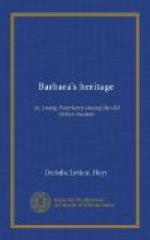But how little she thought that she, herself, was the subject of their conversation, or rather of Miss Sherman’s, who was saying how apparent the devotion of Mr. Sinclair was to every one, and that surely Barbara must reciprocate his feeling, else she would withdraw from him; and how pleasant it was to see such young people, just in the beginning of life, becoming so interested in each other; and how romantic to thus find each other in such a city as Florence; and what an advantage to become allied with such an old, wealthy family as the Sinclairs, and so on and on.
Chapter X.
The Mystery Unfolds to Howard.
We
are in God’s hand.
How strange now looks the
life He makes us lead:
So free we seem, so fettered
fast we are!
I feel He laid the fetter:
let it lie!
—BROWNING.
[Illustration: SAN MINIATO AL MONTE, FLORENCE.]
The weeks sped rapidly on; midwinter had come and gone, and four months had been numbered since Mrs. Douglas had brought Malcom, Margery, Barbara, and Bettina to Italy.
Although social pleasures and duties had multiplied, yet study had never been given up. A steady advance had been made in knowledge of the history of Florence, and of her many legends and traditions. They had not forgotten or passed by the sculptured treasures of the city, but had learned something of Donatello, her first great sculptor; of Lorenzo Ghiberti, who wrought those exquisite gates of bronze for Dante’s “Il mio bel San Giovanni” that Michael Angelo declared to be fit for the gates of Paradise; and of Brunelleschi, the architect of her great Duomo.
Through all had gone on their study of the Florentine painters. After much patient work given to pictures of the fourteenth and fifteenth centuries, they were now quite revelling in the beauty of those of the sixteenth century, or the High Renaissance. This was all the more interesting since they had seen how one after another the early difficulties had been overcome; how each great master succeeding Cimabue had added his contribution of thought and endeavor until artists knew all the laws that govern the art of representation; and how finally, the method of oil-painting having been introduced, they then had a fitting medium with which to express their knowledge and artistic endeavor.
They had read about Leonardo da Vinci, one of the greatest masters, so famous for his portrayal of subtile emotion, and were wonderfully interested in his life and work; had been to the Academy to see the Baptism of Christ, painted by his master, Andrea Verrocchio, and were very positive that the angel on the left, who holds Christ’s garment, was painted by young Leonardo. They had studied his unfinished Adoration of the Magi in the Uffizi—his only authentic work in Florence—and had wished much that they could see his other and greater pictures. Mr. Sumner had told them that in the early summer they would probably go to Milan, and there see the famous Last Supper and Study for the Head of Christ, and that perhaps later they might visit Paris and there find his Mona Lisa and other works.




